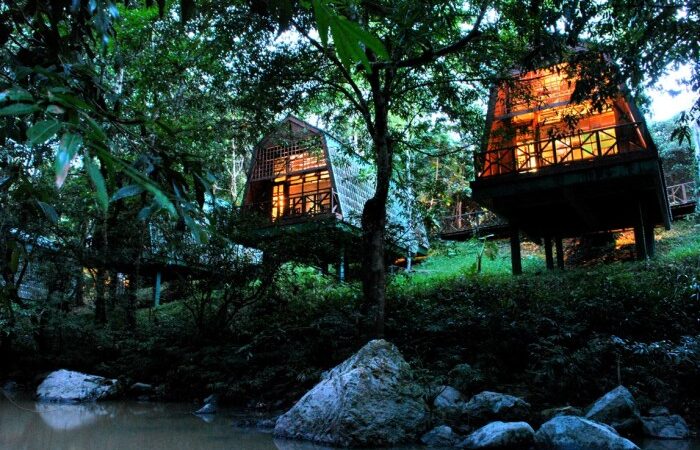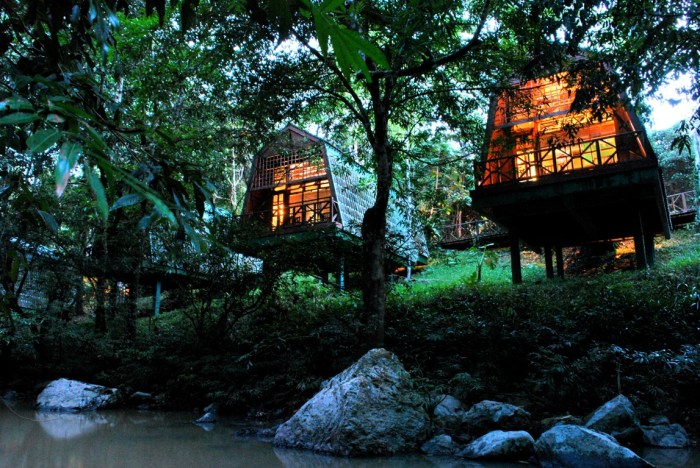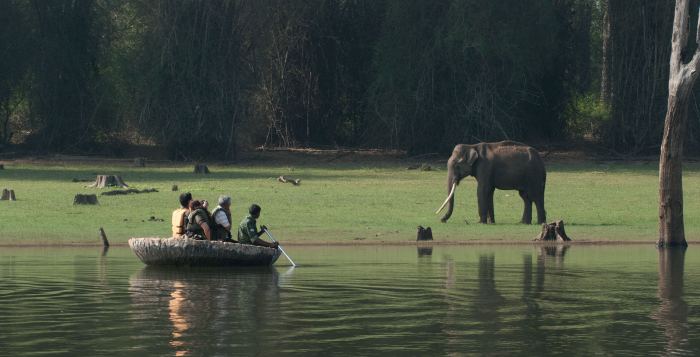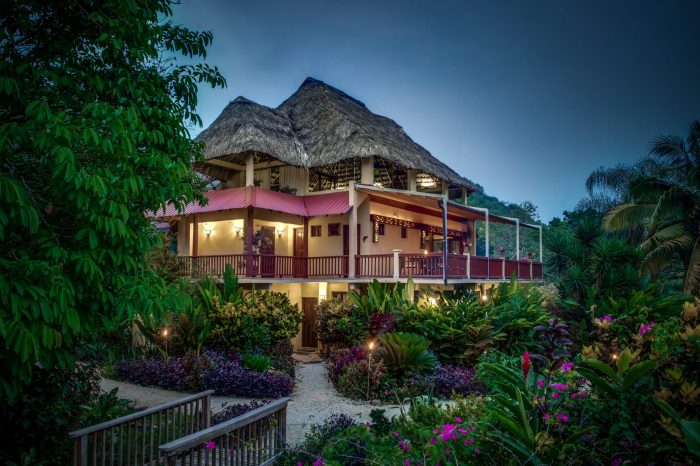Jungle Lodges Your Guide to Rainforest Retreats

Jungle lodges offer an unparalleled escape into the heart of nature’s most vibrant ecosystems. Imagine waking to the sounds of exotic birdsong, surrounded by lush greenery and the promise of incredible wildlife encounters. From rustic eco-lodges to luxurious rainforest retreats, these unique accommodations cater to a wide range of travelers, each promising a memorable adventure.
This guide explores the diverse world of jungle lodges, covering everything from their unique characteristics and locations to the activities they offer and their environmental impact. We’ll delve into the different types of lodges available, discuss accessibility, and examine the sustainable practices employed by eco-conscious operators. Whether you’re a seasoned adventurer or a first-time explorer, this guide will equip you with the knowledge you need to plan your perfect jungle escape.
Defining Jungle Lodges

Source: co.uk
Jungle lodges offer a unique opportunity to experience the beauty and wonder of the rainforest while enjoying varying levels of comfort and luxury. They are accommodations situated within or very near a jungle environment, providing guests with immersive access to the natural world. This immersive experience is central to their appeal, distinguishing them from typical hotels or resorts.
Characteristics of a Typical Jungle Lodge
Typical jungle lodges prioritize integration with their surroundings. They often feature open-air designs, utilizing natural materials and minimizing their environmental impact. A strong emphasis is placed on providing guests with opportunities for wildlife viewing and interaction with nature, frequently incorporating activities like guided nature walks, birdwatching excursions, and potentially even opportunities for close encounters with certain animals under expert supervision. The overall atmosphere is typically relaxed and informal, encouraging guests to unwind and connect with the natural environment.
Luxury Levels in Jungle Lodges
Jungle lodges range significantly in luxury levels. Budget-friendly options might offer basic but clean rooms with shared bathrooms and limited amenities. Mid-range lodges typically provide private rooms with en-suite bathrooms, offering more comfort and potentially some additional amenities like a small swimming pool or restaurant. Luxury lodges, on the other hand, often boast opulent suites with private balconies overlooking the jungle, personalized service, gourmet dining, and a wide array of activities and amenities, such as spa services and private guided tours. For example, a budget lodge might be constructed of simple wood and thatch, while a luxury lodge might incorporate sophisticated materials like sustainably sourced hardwoods and feature elaborate designs inspired by local architecture.
Amenities Commonly Found in Jungle Lodges
The range of amenities varies greatly depending on the lodge’s classification. Common features include comfortable beds, mosquito netting (essential!), private or shared bathrooms, and access to clean water. Many lodges also offer meals, ranging from simple fare to gourmet cuisine. Some offer additional services like laundry, Wi-Fi (although connectivity can be limited in remote locations), and guided tours or excursions. Higher-end lodges might also provide swimming pools, spas, libraries, and gift shops. The availability of these amenities directly influences the overall cost and experience.
Architectural Styles and Building Materials
The architecture and building materials used in jungle lodge construction are often dictated by the surrounding environment and the desired level of luxury. Many lodges utilize sustainable materials like bamboo, timber from sustainably managed forests, and thatch for roofing. Architectural styles frequently reflect local traditions, employing designs that blend seamlessly with the natural landscape. Some lodges might incorporate modern design elements, while others maintain a more rustic aesthetic. For example, a lodge in the Amazon might use locally sourced timber and thatch, while a lodge in Southeast Asia might incorporate traditional stilt houses, reflecting the local architectural heritage. The choice of materials and architectural style directly contributes to the lodge’s overall charm and its environmental impact.
Location and Accessibility of Jungle Lodges
Jungle lodges offer unique accommodations nestled within the heart of diverse ecosystems. Their locations, however, often present significant accessibility challenges, influencing the overall experience and impacting the lodge’s design and operational strategies. Understanding these geographical distributions and access limitations is crucial for potential visitors.
Jungle lodges are predominantly found in tropical and subtropical regions worldwide, encompassing vast swathes of rainforest, wetlands, and other dense, wild areas. These locations include the Amazon rainforest in South America, the Congo Basin in Africa, Southeast Asia (particularly Thailand, Borneo, and Indonesia), and parts of Central America. The specific locations are often chosen for their proximity to unique wildlife, scenic beauty, and relative remoteness, which contributes to the overall appeal of a jungle lodge stay.
Geographical Distribution of Jungle Lodges
The distribution of jungle lodges is heavily influenced by the presence of suitable jungle environments and the level of existing tourism infrastructure. For example, areas with well-established tourism industries, such as certain parts of Costa Rica or Malaysian Borneo, boast a higher density of lodges compared to more remote or less developed regions. Conversely, remote areas often feature lodges that cater to adventurous travelers seeking a truly secluded experience. This results in a varied distribution pattern across the globe, influenced by both natural and human factors.
Accessibility Challenges and Solutions
Reaching remote jungle lodges often presents significant logistical hurdles. Poor road infrastructure, dense vegetation, and challenging terrain frequently impede ground transportation. Rivers, which often serve as natural boundaries and transportation routes, may be impassable during certain seasons. To overcome these challenges, various creative solutions have been implemented. These solutions directly impact the overall cost and travel time associated with reaching the lodge.
Transportation Methods to Jungle Lodges
A variety of transportation methods are used to access jungle lodges, depending on the lodge’s location and the level of infrastructure available. The most common methods include:
| Transportation Method | Advantages | Disadvantages | Example Region |
|---|---|---|---|
| Small Plane/Air Taxi | The fastest method bypasses difficult terrain. | Expensive, weather-dependent, limited luggage capacity. | Amazon Rainforest |
| Boat (Riverboat/Canoe) | Allows access to lodges along rivers, often scenic. | Slow, weather dependent, may be unsafe in rough conditions. | Amazon Rainforest, Mekong Delta |
| 4×4 Jeep/Truck | Relatively versatile, and can handle rough terrain. | Slow, can be uncomfortable on very rough roads. | Costa Rican Rainforests |
| Combination of Methods | Often necessary for optimal access to remote locations. | Requires careful planning and coordination. | Many locations in Southeast Asia |
Accessibility Comparison of Jungle Lodges in Different Regions
The accessibility of jungle lodges varies significantly depending on the region. This table provides a comparative overview, noting that accessibility is often subjective and influenced by individual traveler preferences and physical capabilities.
| Region | Accessibility Rating (1-5, 5 being easiest) | Primary Transportation | Challenges |
|---|---|---|---|
| Costa Rica | 4 | 4×4 Vehicles, Domestic Flights | Some remote lodges still require challenging drives. |
| Amazon Rainforest (Brazil) | 2 | Small Planes, Riverboats | Significant travel time, and weather dependence. |
| Borneo (Malaysia) | 3 | Domestic Flights, 4×4 Vehicles, Boats | Varied accessibility depending on lodge location. |
| Congo Basin | 1 | 4×4 Vehicles, Boats (often challenging) | Extremely challenging terrain, limited infrastructure. |
Activities and Experiences Offered
Jungle lodges offer a wide array of activities designed to immerse you in the natural world and provide unforgettable experiences. From thrilling wildlife encounters to peaceful moments of reflection, there’s something for everyone seeking an adventure in the heart of the jungle. The specific activities available will vary depending on the lodge’s location and the surrounding ecosystem.
Many lodges tailor their activities to the season and the interests of their guests, offering a personalized experience. This ensures that your time is well spent exploring the unique features of the specific jungle environment you’ve chosen.
Common Jungle Lodge Activities
A typical jungle lodge will offer a range of activities catering to diverse interests and fitness levels. These activities are often designed to minimize environmental impact and maximize your chances of witnessing the incredible biodiversity of the region.
- Wildlife Viewing: This is a cornerstone of any jungle lodge experience. Guided tours, both day and night, offer opportunities to spot a variety of animals, from monkeys and sloths to jaguars and tapirs (depending on location).
- Hiking and Nature Walks: Explore jungle trails with expert guides who can identify plants, animals, and insects. These walks vary in difficulty, offering options for both casual strollers and seasoned hikers.
- Birdwatching: The jungles are teeming with vibrant and diverse birdlife. Experienced guides can help you identify species and understand their behaviors.
- Canoeing and Kayaking: Explore rivers and waterways, offering a unique perspective of the jungle environment and increased chances of spotting wildlife from a different vantage point.
- Night Walks: Experience the jungle’s nocturnal creatures, often revealing a different side of the ecosystem not visible during the day. These walks often involve using spotlights and are guided by experienced personnel.
- Cultural Experiences: Some lodges offer interactions with local communities, providing insights into their traditions, customs, and ways of life. This can include visits to villages or participation in local ceremonies.
Sample Three-Day Jungle Lodge Itinerary
This itinerary provides a framework; specific activities will vary based on the lodge and the season. Remember to always check with your lodge for their specific offerings and schedules.
- Day 1: Arrival and Jungle Introduction. Settle into your lodge, followed by a guided nature walk to familiarize yourself with the local flora and fauna. Enjoy a sunset river cruise, looking for caiman and other nocturnal animals.
- Day 2: Wildlife Spotting Adventure. Embark on a full-day guided jungle trek focusing on wildlife observation. This could include a visit to a specific area known for monkey sightings or a birdwatching expedition. In the evening, participate in a night walk to witness nocturnal wildlife.
- Day 3: Cultural Immersion and Departure. Visit a nearby indigenous community (if offered by the lodge) to learn about their culture and traditions. Enjoy a final jungle breakfast before departing.
Wildlife Viewing Opportunities by Location
The wildlife you encounter will greatly depend on the geographical location of the jungle lodge. Different regions boast unique ecosystems and inhabitants.
- Amazon Rainforest: Expect to see monkeys (howler monkeys, spider monkeys), sloths, macaws, jaguars, caimans, anacondas, pink river dolphins, and countless insect species.
- Southeast Asian Jungles (e.g., Borneo, Thailand): Orangutans (Borneo), gibbons, elephants, tigers (depending on location), various species of snakes, colorful birds (hornbills, kingfishers), and a wide array of insects and reptiles.
- African Jungles: Gorillas (specific regions), chimpanzees, various primates, leopards, elephants, and a variety of birds and insects. The specific wildlife depends heavily on the region within Africa.
Comparing Jungle Lodge Experiences
The experience offered by jungle lodges varies significantly depending on their location and the type of jungle they are situated in. These differences influence the type of wildlife encountered, the activities available, and the overall atmosphere.
| Feature | Amazon Rainforest Lodge | Southeast Asian Jungle Lodge |
|---|---|---|
| Wildlife | Primates, large cats, reptiles, diverse birdlife | Primates (orangutans, gibbons), large cats (tigers in some areas), elephants (in some areas), diverse birdlife |
| Activities | River trips, canopy walks, night hikes | Jungle treks, wildlife spotting, cultural village visits |
| Atmosphere | Hot and humid, lush vegetation | Variable depending on location can be hot and humid or more temperate |
Environmental Impact and Sustainability
Jungle lodge tourism, while offering incredible experiences, inevitably impacts the delicate ecosystems they inhabit. Understanding and mitigating this impact is crucial for the long-term viability of both the lodges and the environment they depend on. Responsible tourism practices are essential to ensure the preservation of these unique habitats for future generations.
The environmental impact of jungle lodges can include habitat loss from construction, increased waste generation, water pollution from sewage and detergents, and disturbance to wildlife through noise and human presence. Unsustainable practices can lead to deforestation, soil erosion, and the disruption of natural ecological processes. However, many lodges are actively working to minimize their negative footprint and promote sustainability.
Sustainable Practices Employed by Eco-Friendly Jungle Lodges
Eco-conscious jungle lodges prioritize minimizing their environmental impact through a variety of sustainable practices. These practices not only protect the surrounding environment but also enhance the guest experience by immersing visitors in the natural beauty of the jungle.
- Waste Management: Implementing comprehensive waste management systems, including composting organic waste, recycling, and proper disposal of non-recyclable materials. This reduces landfill waste and minimizes pollution.
- Water Conservation: Utilizing low-flow fixtures, rainwater harvesting systems, and efficient irrigation techniques to conserve water resources. Many lodges also treat wastewater before releasing it back into the environment.
- Energy Efficiency: Employing solar power, energy-efficient appliances, and responsible lighting to reduce reliance on fossil fuels and minimize carbon emissions. Some lodges even utilize biofuels for cooking.
- Sustainable Sourcing: Procuring locally sourced food and materials whenever possible to reduce transportation emissions and support local communities. This often includes using locally grown produce for meals.
- Wildlife Protection: Implementing measures to protect local wildlife, such as avoiding disturbance of nesting sites, implementing responsible wildlife viewing guidelines, and supporting local conservation efforts. This often involves working with local communities and organizations.
- Community Engagement: Partnering with local communities to create employment opportunities and foster a sense of shared responsibility for environmental protection. This can include employing local guides and staff, sourcing supplies locally, and contributing to community projects.
Examples of Initiatives Minimizing Environmental Footprint
Several lodges showcase excellent examples of environmental stewardship. For instance, some lodges have implemented carbon offsetting programs, investing in renewable energy projects to compensate for their carbon emissions. Others have established reforestation projects, actively planting trees to restore deforested areas. A lodge in the Amazon, for example, has successfully integrated a sustainable agroforestry system, combining the cultivation of crops with the preservation of forest areas, benefiting both the environment and local communities. Another lodge in Costa Rica uses biogas digesters to generate energy from organic waste, further reducing their reliance on fossil fuels. These initiatives demonstrate the tangible steps lodges are taking to minimize their environmental impact.
Jungle Lodge Pricing and Target Audience
Pricing a jungle lodge stay involves a complex interplay of factors, ensuring profitability while remaining competitive and accessible to the target market. Understanding these factors is crucial for lodge owners to set prices that reflect the value offered and attract the desired clientele.
Factors influencing pricing are diverse and interconnected. Location plays a significant role; lodges in remote, less accessible areas with unique wildlife viewing opportunities command higher prices than those closer to towns or with less exceptional wildlife. The level of luxury and amenities offered also directly impacts pricing. Luxury lodges with private plunge pools, gourmet dining, and personalized service naturally charge more than budget-friendly options with basic rooms and communal facilities. Seasonality is another key factor; peak seasons, often coinciding with optimal weather and wildlife viewing, see significantly higher rates than the off-season. Operational costs, including staff salaries, maintenance, and environmental conservation efforts, also influence pricing decisions. Finally, the overall market demand and competition within the region also play a crucial role in setting prices.
Target Audience Segmentation
Different jungle lodges cater to specific target audiences, directly influencing their pricing strategies. Budget-friendly lodges typically target backpackers, eco-conscious travelers, and students seeking affordable adventures. These lodges prioritize affordability over luxury, offering basic but comfortable accommodations and focusing on immersive nature experiences. In contrast, luxury lodges attract affluent travelers seeking high-end comfort, personalized service, and exclusive wildlife encounters. They offer premium amenities, gourmet dining, and private guides, justifying their higher price points. Family-oriented lodges cater to families with children, providing child-friendly activities, family suites, and potentially babysitting services. Adventure-focused lodges target thrill-seekers, offering activities such as zip-lining, white-water rafting, and jungle trekking, reflecting these activities in their pricing.
Pricing Strategies Based on Location, Amenities, and Seasonality
Pricing strategies are dynamically adjusted based on these factors. A luxury lodge in the Amazon rainforest, known for its biodiversity and remote location, will command significantly higher prices than a budget-friendly lodge in a more accessible area with fewer amenities. During peak season, all lodges generally increase their rates to capitalize on high demand, often implementing dynamic pricing models that adjust rates based on real-time availability and demand. Conversely, off-season discounts attract budget-conscious travelers and help maintain occupancy. Lodges may also offer packages that bundle accommodation with activities, offering value to the customer and potentially increasing revenue.
Comparative Pricing of Jungle Lodges
The table below illustrates a comparison of pricing across different locations and lodge types, reflecting the influence of location, amenities, and seasonality on pricing. Note that these are illustrative examples and actual prices may vary.
| Location | Lodge Type | Peak Season Price (USD/night) | Off-Season Price (USD/night) |
|---|---|---|---|
| Amazon Rainforest, Brazil | Luxury Lodge | 1500 | 1000 |
| Costa Rica Rainforest | Mid-Range Lodge | 300 | 200 |
| Borneo Rainforest, Malaysia | Budget Lodge | 50 | 40 |
| Peruvian Amazon | Eco-Lodge | 250 | 150 |
Illustrative Examples of Jungle Lodges

Source: junglelodges.com
Choosing the right jungle lodge depends heavily on your priorities – adventure, relaxation, luxury, or a blend of all three. The following examples showcase the diversity found within the jungle lodge experience, highlighting how the environment shapes the lodge’s design and activities.
The Amazonian Canopy Lodge, Brazil
The Amazonian Canopy Lodge is nestled high within the rainforest canopy of the Amazon basin, accessible only by boat. This unique location influences every aspect of the lodge, from its design to the activities offered. The lodge’s architecture seamlessly integrates with the surrounding environment.
The lodge is built primarily from sustainably sourced timber, with thatched roofs that blend in with the surrounding foliage. Interior design emphasizes natural materials – woven textiles, locally crafted furniture, and earthy tones – creating a feeling of tranquil immersion within the rainforest. Large windows offer breathtaking views of the canopy, while open-air walkways connect the individual suites, allowing guests to experience the sounds and smells of the jungle up close. Activities offered include guided jungle treks, night-time wildlife spotting, and canoe trips down the river, providing an immersive experience of the Amazonian ecosystem.
The Sri Lankan Tea Plantation Lodge, Sri Lanka
Unlike the Amazonian Canopy Lodge, the Sri Lankan Tea Plantation Lodge offers a different kind of jungle experience, situated amidst lush tea plantations in the central highlands of Sri Lanka. The lodge’s design reflects the colonial history of the region and the beauty of the tea plantations.
The architecture combines colonial-era aesthetics with modern comfort. Buildings feature wide verandas offering stunning views of the rolling hills covered in tea bushes. The interior design blends traditional Sri Lankan craftsmanship with contemporary touches. Local hardwoods are used throughout, alongside vibrant textiles and handcrafted furniture. Guests can enjoy activities such as tea plantation tours, hikes through the surrounding rainforest, and visits to nearby villages, offering a cultural immersion alongside the natural beauty.
The Borneo Rainforest Retreat, Malaysia
The Borneo Rainforest Retreat is situated on the edge of the rainforest in Malaysian Borneo, offering a unique blend of jungle exploration and luxurious comfort. The design of the lodge takes its inspiration from traditional longhouses of the indigenous Dayak people.
The lodge features long, single-story buildings with high, pitched roofs, constructed using sustainable materials such as bamboo and timber. Interior design emphasizes natural light and ventilation, with large windows and open-plan living spaces. Locally sourced materials are used extensively, including woven rattan furniture and handcrafted textiles. Guests can participate in a range of activities, from exploring the rainforest on guided walks to observing orangutans in their natural habitat and learning about the region’s unique biodiversity. The lodge’s commitment to sustainability is evident in its design, operations, and the conservation efforts it supports.
Last Word

Source: travelbelize.org
Ultimately, choosing a jungle lodge is about more than just a place to sleep; it’s about immersing yourself in the beauty and wonder of the natural world. By understanding the different types of lodges, their locations, activities, and environmental impact, you can make an informed decision that aligns with your travel style and values. So pack your bags, embrace the adventure, and prepare to be captivated by the magic of the jungle.
FAQ Explained
What’s the best time of year to visit a jungle lodge?
The best time varies by location. Generally, dry seasons offer better weather for activities, but the rainy season can bring lusher landscapes and fewer crowds.
Are jungle lodges safe?
Reputable lodges prioritize safety with trained staff and appropriate security measures. However, it’s always wise to research the lodge and its safety protocols before booking.
What should I pack for a jungle lodge stay?
Pack light, breathable clothing, sturdy shoes, insect repellent, sunscreen, a raincoat, a hat, and binoculars. Check the lodge’s specific recommendations.
What if I have allergies or dietary restrictions?
Most lodges can accommodate dietary needs with advance notice. Inform them of any allergies or restrictions when booking.
Do I need travel insurance for a jungle lodge trip?
Yes, comprehensive travel insurance is highly recommended, especially for remote locations. It covers medical emergencies, trip cancellations, and lost belongings.
Comments are closed.